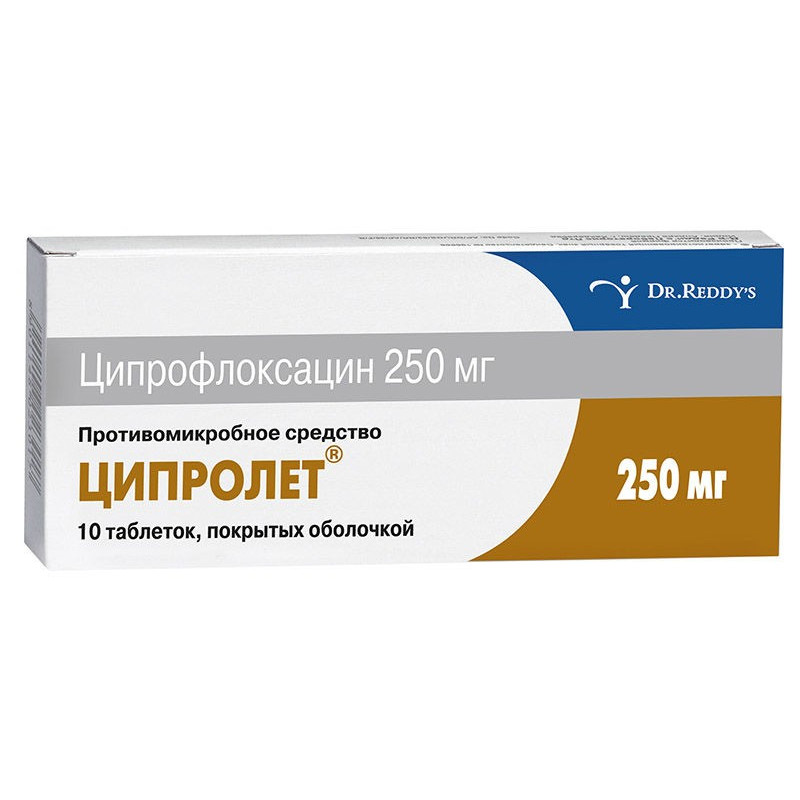



 All payments are encrypted via SSL
All payments are encrypted via SSL
 Full Refund if you haven't received your order
Full Refund if you haven't received your order
Tsiprolet infusion solution - clear colorless liquid
100 ml of solution (1 bottle) contain 200 mg of Ciprofloxacin;
Tsiprolet coated tablet
1 pill contains ciprofloxacin (as monohydrate hydrochloride) 250, 500 mg;
10 pills per pack.
Tsiprolet is an antimicrobial drug of the fluoroquinolone group.
The mechanism of action of ciprofloxacin is associated with the effect on the DNA gyrase (topoisomerase) of bacteria, which plays an important role in the reproduction of bacterial DNA. The drug has a rapid bactericidal effect on microorganisms that are both in the resting stage and in reproduction.
The range of action of Ciprolet includes the following types of gram-negative and gram-positive microorganisms:
E.coli, Shigella, Salmonella, Citrobacter, Klebsiella, Enterobacter, Serratia, Hafnia, Edwardsiella, Proteus (indole-positive and indole-negative), Providencia, Moprganella, Yersinia, Vibrio, Aeromonas, Рlesiomonas, your search, your search, your search, your search, yours, Yersinia, Vibrio, Aeromonas, Plesiomonas, your, your, your, your;, Moraxella, Branhamella, Acinetobacter, Brucella, Staphylococcus, Sreptococcus agalactiae, Listeria, Corynebacterium, Chlamydia.
Ciprofloxacin is effective against beta-lactamase producing bacteria.
Sensitivity to ciprofloxacin ranges from: Gardnerella, Flavobacterium, Alcaligenes, Streptococcus faecalis, Streptococcus pyogenes, Streptococcus pneumonia, Streptococcus viridans, Mycoplasma hominis, Mycobasterium tuberculosis, Mycobacterium fortuitum
Most commonly resistant: Streptococcus faecium, Ureaplasma urealyticum, Nocardia asteroides.
Anaerobes, with some exceptions, are moderately sensitive (Peptococcus, Peptostreptococcus) or resistant (Bacteroides).
Ciprofloxacin does not affect Treponema pallidum and fungi.
Resistance to ciprofloxacin is produced slowly and gradually, plasmid resistance is absent.Ciprofloxacin is active against pathogens that are resistant, for example, to beta-lactam antibiotics, aminoglycosides or tetracyclines.
Treatment of uncomplicated and complicated infections caused by pathogens sensitive to the drug:
Hypersensitivity to ciprofloxacin and other drugs of the quinolone group; pregnancy; lactation; children and adolescents.
Carefully use in elderly patients; patients with epilepsy, seizures with history of history, vascular diseases and organic brain damage due to the risk of adverse reactions from the central nervous system, ciprofloxacin should be prescribed only for health reasons.
During treatment with ciprofloxacin, adequate hydration is necessary for the prevention of possible criticaluria.
Ciprolet pills should be swallowed without chewing, with a liquid. The drug can be taken regardless of the meal. Acceptance on an empty stomach accelerates the absorption of the active substance.
The following indicative doses are recommended:
Uncomplicated infections of the lower and upper urinary tract - 100 mg 2 times a day.
Complicated urinary tract infections (depending on severity) - 200 mg 2 times a day.
Respiratory tract infections - 200-400 mg 2 times a day.
Other infections - 200-400 mg 2 times a day.
Acute gonorrhea and acute uncomplicated cystitis in women, a single dose of 200 mg can be treated (intravenously).
With urinary tract infections, including in acute uncomplicated gonorrhea, ciprofloxacin can be administered intravenously at a dose of 100 mg 2 times a day. For respiratory tract infections, depending on the severity and pathogen, ciprofloxacin is administered in a dose of 200-400 mg 2 times a day, with other infections - 200-400 mg 2 times a day.
As the patient's condition improves, they switch to taking the drug inside.
It is recommended to continue treatment for at least 3 days after normalization of temperature or disappearance of clinical symptoms. The course of treatment is 7-14 days. In patients with reduced immunity, treatment is carried out during the entire period of neutropenia.
Cardiovascular: In very rare cases - tachycardia, hot flashes, migraine, fainting.
From the digestive tract and liver: nausea, vomiting, diarrhea, digestive disorders, abdominal pain, flatulence, lack of appetite.
From the nervous system and psyche: dizziness, headache, fatigue, insomnia, agitation, tremor; in very rare cases: peripheral sensory disturbances, sweating, instability of gait, seizures, convulsions, fear and confusion, nightmares, depression, hallucinations, taste and smell disorders, visual disturbances (diplopia, chromatopsia), tinnitus, temporary hearing loss especially in high sounds. If these reactions occur, the drug should be discontinued immediately and notify the attending physician.
Hemic and lymphatic: eosinophilia, leukopenia, thrombocytopenia, very rarely - leukocytosis, thrombocytosis, hemolytic anemia.
Allergic and immunopathological reactions: skin rashes, itching, drug fever, and photosensitization; rarely - angioedema, bronchospasm, arthralgia; very rarely - anaphylactic shock, myalgia, Stevens-Johnson syndrome, Lyell's syndrome, interstitial nephritis, hepatitis.
Local reactions: phlebitis
Musculoskeletal system: single - ruptures of the tendons of the shoulder, arms and the Achilles tendon, requiring surgical intervention. If complaints arise, treatment should be discontinued.
Impact on laboratory parameters: especially in patients with impaired liver function, there may be a temporary increase in transaminase and alkaline phosphatase levels, as well as cholestatic jaundice: a temporary increase in the concentration of urea, creatinine and bilirubin in the blood serum, hyperglycemia.
Tsiprolet
